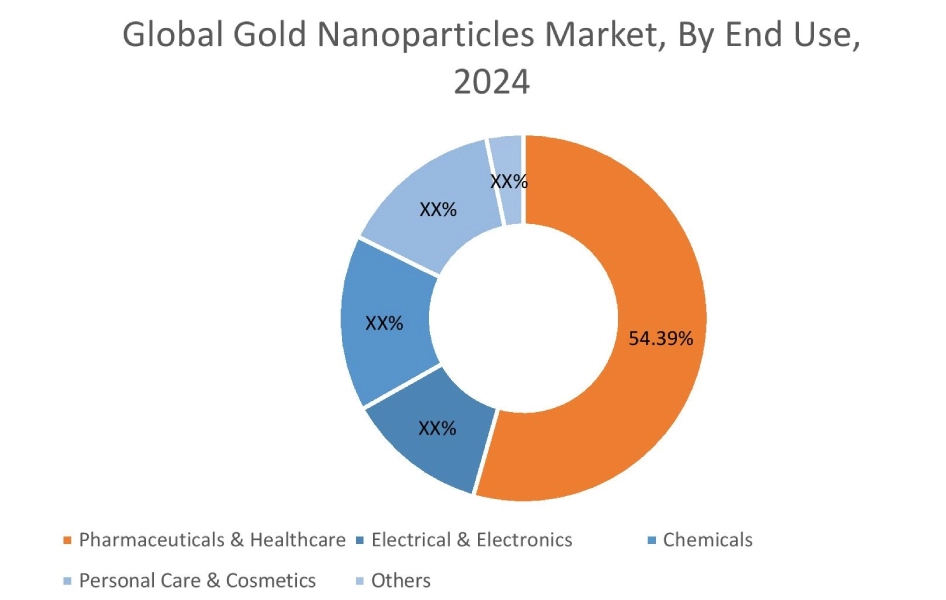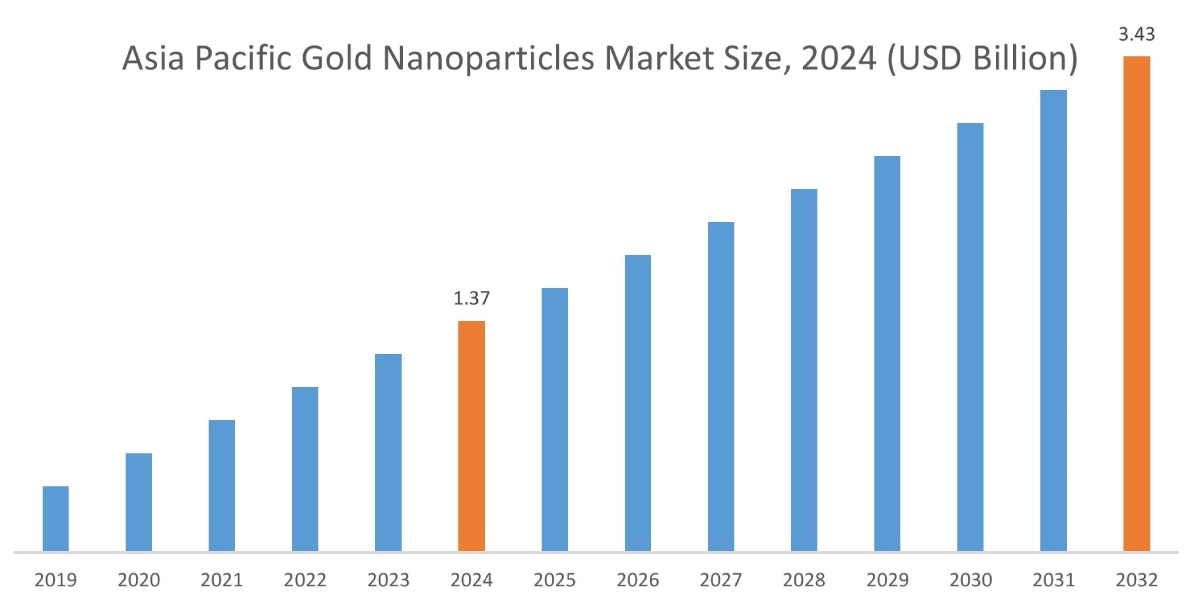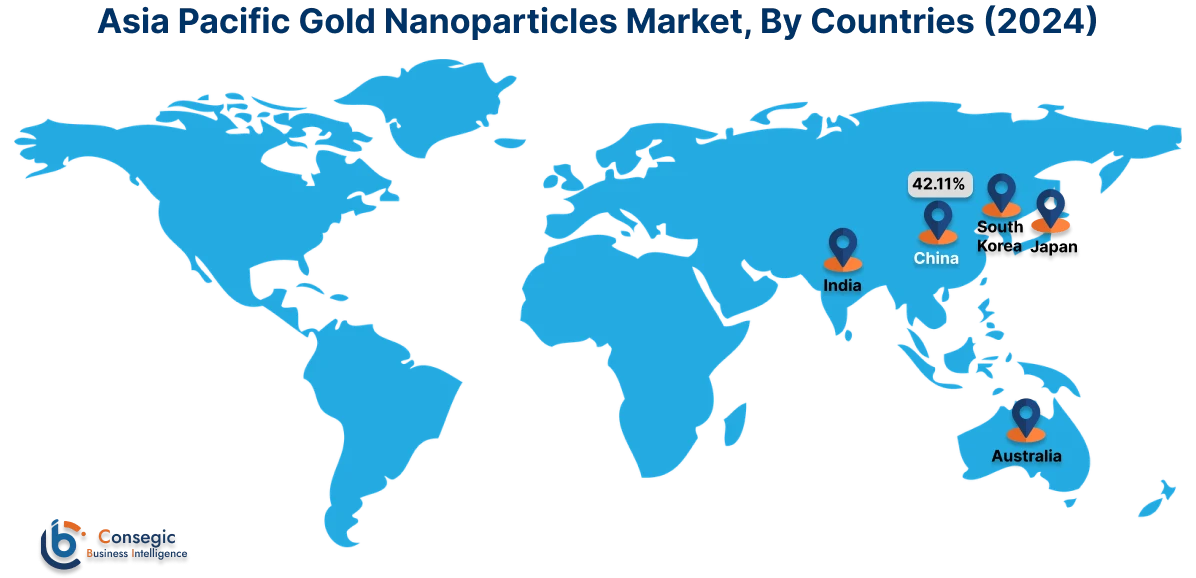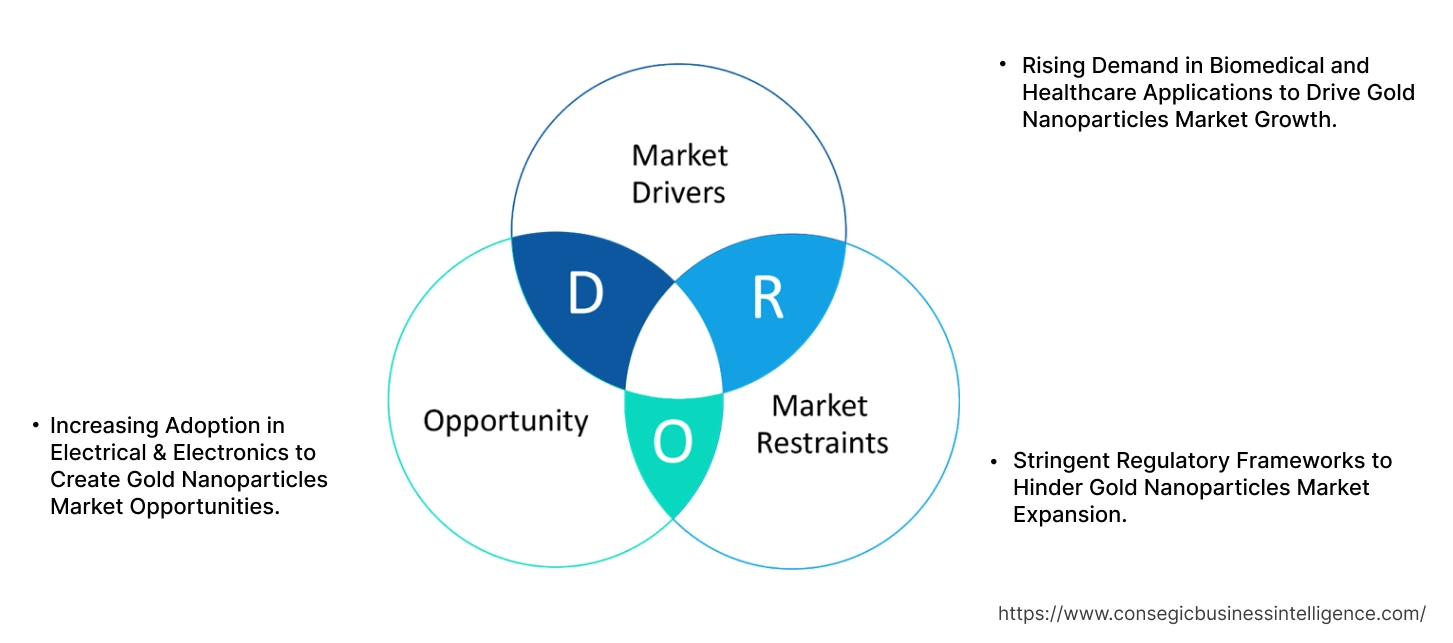Gold Nanoparticles Market Size:
The Gold Nanoparticles Market size is growing with a CAGR of 15.1% during the forecast period (2025-2032), and the market is projected to be valued at USD 10.47 Billion by 2032 from USD 3.42 Billion in 2024. Additionally, the market value for 2025 is attributed to USD 3.92 Billion.
Gold Nanoparticles Market Scope & Overview:
Gold nanoparticles are nanoscale particles of gold, typically measuring between 1 and 100 nanometers. At this diminutive scale, gold exhibits unique physicochemical properties distinct from its bulk form, primarily due to quantum mechanical effects and a significantly increased surface-area-to-volume ratio. These properties include tunable surface plasmon resonance, which imparts vibrant colors to their solutions, remarkable biocompatibility, and excellent catalytic activity. Hence, these nanoparticles are finding significant uses across various scientific disciplines, finding widespread application in areas such as advanced biomedical diagnostics, targeted drug delivery, catalysis, and cutting-edge electronics among others.
Gold Nanoparticles Market Dynamics - (DRO) :
Key Drivers:
Rising Demand in Biomedical and Healthcare Applications to Drive Gold Nanoparticles Market Growth.
Gold nanoparticles distinguished by their exceptional biocompatibility, tunable optical properties, and ease of functionalization, are proving transformative across various medical fields. They are increasingly utilized in advanced diagnostics for highly sensitive and rapid detection of diseases, enabling earlier intervention. Furthermore, these nanoparticles serve a crucial role in targeted drug delivery systems, allowing therapeutics to be delivered precisely to diseased cells, thereby minimizing side effects and improving treatment efficacy, particularly in oncology. Their role as contrast agents in medical imaging and as radiosensitizers in cancer therapies like proton therapy further underscores their growing importance, driving substantial investment and market growth.
- For instance, in 2024, CD Bioparticles has launched new Flow Cytometry Gold Nanoparticles, designed to enhance cell analysis by offering a sensitive and versatile tool for instrument tuning and precise evaluation of particle populations in solution, leveraging gold nanoparticles' strong light scattering, high surface area, and tunable surface chemistry for specific biomolecule coupling and detection in complex biological samples.
Thus, as per the analysis, the growing market for these tiny gold particles in biomedical and healthcare applications is fueling significant gold nanoparticles market growth.
Key Restraints:
Stringent Regulatory Frameworks to Hinder Gold Nanoparticles Market Expansion.
Regulatory bodies globally, including the U.S. FDA and the European Medicines Agency (EMA), are focusing on how to effectively assess and regulate these novel materials, often lacking standardized definitions, testing protocols, and clear approval pathways. This regulatory uncertainty translates into lengthy and costly approval processes for new gold nanoparticle-based products, particularly in the critical pharmaceutical and healthcare industries. The absence of globally harmonized guidelines and the need for extensive toxicity profiling further compound the challenge, increasing R&D costs and delaying market entry, thereby hindering the widespread adoption and commercialization of gold nanoparticle applications. As a result, the above-mentioned factors are limiting gold nanoparticles market expansion.
Future Opportunities :
Increasing Adoption in Electrical & Electronics to Create Gold Nanoparticles Market Opportunities.
Exceptional electrical conductivity, chemical stability, and nanoscale dimensions of gold nanoparticles make them suitable for the ongoing miniaturization trend in electronics. These nanoparticles are increasingly utilized in conductive inks for flexible and printed electronics, enabling thinner, more efficient circuits for devices such as smartphones, tablets, and wearables. Furthermore, their role in advanced nanosensors, high-performance transistors, and memory storage devices is expanding. The growth of 5G networks and IoT where gold nanoparticles offer crucial solutions for battery insulation and power management, further solidifies their pivotal role and market potential in this sector.
- For instance, according to IoT Analytics, the number of connected Internet of Things (IoT) devices is projected to reach 40 billion by the year 2030.
Henceforth, the adoption in electrical & electronics are creating lucrative gold nanoparticles market opportunities over the forecast period.
Gold Nanoparticles Market Segmental Analysis :
By Shape:
Based on Shape, the market is categorized into spheres, rods, cages, shells, and others.
Trends in Shape:
- There's a growing trend to utilize gold nanospheres for increasing the sensitivity and accuracy of point-of-care diagnostics, such as lateral flow assays, for rapid detection of various biomarkers and pathogens.
- A major trend is the refinement of gold nanorods for more effective and localized cancer treatment.
The spheres segment accounted for the largest gold nanoparticles market share in 2024.
- Gold nanospheres are the most prevalent and straightforward gold nanoparticle shape to synthesize, exhibiting a characteristic Surface Plasmon Resonance (SPR) in the visible light spectrum, often appearing red for smaller particles.
- Their well-established synthesis methods allow for precise control over size and uniformity. These spherical nanoparticles find extensive use in diagnostics and biosensing, particularly in lateral flow assays and colorimetric detection systems, owing to their distinct color changes.
- Furthermore, they serve as fundamental carriers for drug and gene delivery, function as electron-dense probes in microscopy, and demonstrate catalytic activity across various chemical reactions.
- Thus, as per the gold nanoparticles market analysis, the spheres segment dominates the gold nanoparticles market demand.
Shells segment is expected to grow at the fastest CAGR over the forecast period.
- Gold nanoshells are unique gold nanoparticles characterized by a dielectric core, typically silica, enveloped in a thin gold layer.
- Their surface plasmon resonance are tunable across visible and near-infrared spectra by adjusting the core-to-shell ratio, enabling exquisite control over light absorption and scattering.
- For instance, in 2022, TANAKA Kikinzoku Kogyo K.K. announced the development of novel gold shell nanoparticles featuring high dispersion stability, designed to coat particle surfaces like silica with an approximately 10 nm thick gold shell, exhibiting strong surface plasmon resonance and enabling the preparation of dispersion liquids with significantly higher concentrations than existing market offerings.
- Furthermore, their light-responsive nature facilitates drug delivery by triggering release upon NIR exposure, and they serve as effective contrast agents in bioimaging and in optical filter applications.
- Overall, considering aforementioned factors shell segment is expected to grow over forecast period.
By End Use:
Based on End Use, the market is categorized into pharmaceuticals & healthcare, electrical & electronics, chemicals, personal care & cosmetics, and others.
Trends in the End Use:
- A key trend is increasing focus on targeted drug delivery systems utilizing gold nanoparticles to enhance therapeutic efficacy and minimize off-target effects in cancer and other diseases.
- Expanding use in advanced nanosensors and memory storage devices due to unique electrical properties and stability, crucial for IoT and smart technologies is growing trend.
The pharmaceuticals & healthcare segment accounted for the largest Gold Nanoparticles market share of 54.39% in 2024.
- The extensive and growing application of gold nanoparticles in modern medicine drives this segment.
- They are crucial for targeted drug delivery, allowing precise delivery of therapeutic agents to diseased cells with reduced systemic side effects.
- In diagnostics, their unique optical properties enable highly sensitive biosensors and in-vitro assays for early disease detection and rapid testing.
- They also serve as effective contrast agents in medical imaging and radiosensitizers in radiation therapies, enhancing treatment efficacy.
- The increasing global healthcare expenditure, prevalence of chronic diseases, and advancements in nanomedicine heavily support this segment's revenue.
- Thus, as per the aforementioned factors, the pharmaceuticals & healthcare segment is dominating market growth.
The electrical & electronics segment is expected to grow at the fastest CAGR over the forecast period.
- The growing focus on miniaturization in electronic devices coupled with the escalating demand for superior performance and flexibility is a primary factor for the increasing adoption of gold nanoparticles in electrical and electronics.
- Their excellent electrical conductivity and inherent stability make them highly suitable for applications such as conductive inks in flexible and printed electronics, facilitating the development of compact and efficient circuits for modern portable devices.
- Moreover, these nanoparticles play a pivotal role in advanced nanosensors, transistors, and memory storage. The rise of IoT further supports the segment revenue.
- For instance, according to the State of IoT Summer, the number of connected IoT devices increased by 15% from 2022 to the end of 2023.
- Thus, based on the market analysis, electrical & electronics is the fastest growing segment in the gold nanoparticles market demand.

Regional Analysis:
The regional segment includes North America, Europe, Asia Pacific, the Middle East and Africa, and Latin America.

In 2024, Asia Pacific accounted for the highest market share at 40.11% and was valued at USD 1.37 Billion and is expected to reach USD 3.43 Billion in 2032. In Asia Pacific, the China accounted for a market share of 42.11% during the base year of 2024. The significant role of healthcare and pharmaceutical sectors, coupled with substantial investments in nanotechnology research and development. The high prevalence of chronic diseases fuels demand for advanced diagnostics and therapies, further driven by numerous key market players and research institutions.
- For instance, according to data published on NCBI in 2023, among older adults in China, the national prevalence of any chronic disease was found to be 81.1% encompassing an estimated 179.9 million individuals.
The region's growing need for nanotech products in medical diagnostics, tumor detection, and enhanced drug delivery systems are pivotal factors. Thus, as per analysis, these factors collectively position North America as a key region for the market.

In Europe, the gold nanoparticles industry is experiencing the fastest growth with a CAGR of 19.8% over the forecast period owing to accelerating pharmaceutical and electronics manufacturing bases. Countries such as China, India, Japan, and South Korea are witnessing substantial investments and advancements in these sectors. The expanding pharmaceutical sector is increasingly incorporating gold nanoparticles for advanced diagnostics, targeted drug delivery systems, and novel therapeutic approaches. Concurrently, the region's robust electronics manufacturing, characterized by high performance in devices such as smartphones, wearables, among others, relies heavily on these tiny gold particles for conductive inks, advanced sensors, and efficient insulation, collectively fueling this remarkable market expansion. Collectively these factors fuel Europe gold nanoparticles market analysis.
North American market is driven by its robust integration with next-generation therapies and diagnostics. The region presents advanced healthcare systems and focused nanomedicine research. American initiatives and significant investments in R&D, including substantial funding for projects focusing on nanomedicine designs for brain diseases and sepsis treatment, are accelerating the translation of gold nanoparticle research into clinical applications. Hence, as per analysis, these factors collectively present a positive impact on the European gold nanoparticles market trends.
The market in Latin America is defined by emerging applications in the personal care & cosmetics sector. This region's beauty market is one of the fastest-growing globally, influenced by a dynamic consumer base, rising disposable incomes, and a strong cultural emphasis on beauty and personal care. Within this evolving landscape, gold nanoparticles are finding increasing use in premium cosmetic formulations. They are valued for their potential to enhance product efficacy, stability, and aesthetic appeal, being incorporated into anti-aging creams, serums, and other high-end skincare products. As Latin American consumers become more discerning and seek advanced, innovative beauty solutions, they are propelling the gold nanoparticles market trends.
The market trends in Middle East and Africa are characterized by increasing investments in healthcare infrastructure across the region. Governments and private entities in various nations are actively channeling funds into upgrading and expanding their healthcare facilities, including hospitals, clinics, and research centers. This focus on improving healthcare access and quality, positively impacts the necessity for advanced medical technologies. As these regions strengthen their diagnostic capabilities and introduce more sophisticated treatment modalities, the need for cutting-edge materials for applications in imaging, targeted drug delivery, and biosensing consequently increases, creating new opportunities for market growth.
Top Key Players and Market Share Insights:
The Global Gold Nanoparticles Market is highly competitive with major players providing products to the national and international markets. Key players are adopting several strategies in research and development (R&D) and product innovation to hold a strong position in the global Gold Nanoparticles market. Key players in the Gold Nanoparticles industry include
- BBI Solutions (UK)
- Cytodiagnostics Inc. (Canada)
- CD Bioparticles (U.S.)
- Nano Labs (India)
- NanoHybrids Inc. (U.S.)
- Fortis Life Sciences, LLC. (U.S.)
- TANAKA Precious Metal Group Co., Ltd. (Japan)
- Merck KGaA (Germany)
- Meliorum Technologies, Inc. (U.S.)
- Nanopartz, Inc. (U.S.)
Recent Industry Developments :
Product Launch:
- In 2022, TANAKA Kikinzoku Kogyo K.K. announced the development of novel gold shell nanoparticles engineered for high concentration preparation and exceptional dispersion stability. This product features an extremely thin gold shell, approximately 10 nm thick, designed to cover particle surfaces such as silica, and exhibits strong surface plasmon resonance. Notably, its high dispersion stability in water and polar solvents allows for the creation of dispersion liquids with concentrations 100 to 1,000 times greater than those of currently available gold nanoparticles.
Gold Nanoparticles Market Report Insights :
| Report Attributes | Report Details |
| Study Timeline | 2019-2032 |
| Market Size in 2032 | USD 10.47 Billion |
| CAGR (2025-2032) | 15.1% |
| By Shape |
|
| By End Use |
|
| By Region |
|
| Key Players |
|
| North America | U.S. Canada Mexico |
| Europe | U.K. Germany France Spain Italy Russia Benelux Rest of Europe |
| APAC | China South Korea Japan India Australia ASEAN Rest of Asia-Pacific |
| Middle East and Africa | GCC Turkey South Africa Rest of MEA |
| LATAM | Brazil Argentina Chile Rest of LATAM |
| Report Coverage |
|
Key Questions Answered in the Report
How big is the Gold Nanoparticles market? +
In 2024, the Gold Nanoparticles market is USD 3.42 Billion.
Which is the fastest-growing region in the Gold Nanoparticles market? +
Europe is the fastest-growing region in the Gold Nanoparticles market.
What specific segmentation details are covered in the Gold Nanoparticles market? +
By Shape and End Use segmentation details are covered in the Gold Nanoparticles market.
Who are the major players in the Gold Nanoparticles market? +
BBI Solutions (UK), Cytodiagnostics Inc. (Canada), Fortis Life Sciences, LLC. (U.S.), TANAKA Precious Metal Group Co., Ltd. (Japan) are some of the major players in the market.


